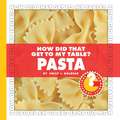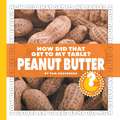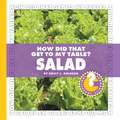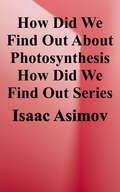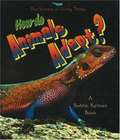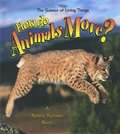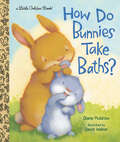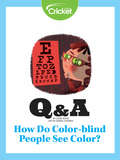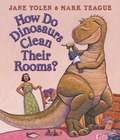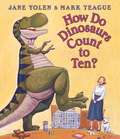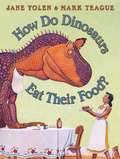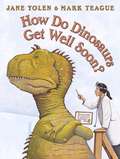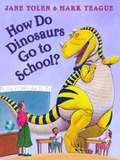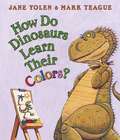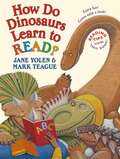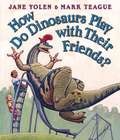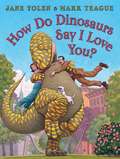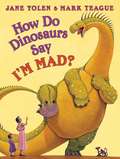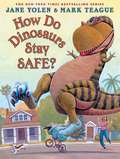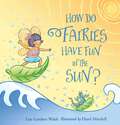- Table View
- List View
How Did That Get to My Table? Pasta (Community Connections)
by Emily J. DolbearWith this title, young readers will gain an understanding on how the pasta they love, is made and how it ends up on their table. Picture descriptions and captions included.
How Did That Get to My Table? Peanut Butter (Community Connections)
by Pam RosenbergCOMMUNITY CONNECTIONS--HOW DID THAT GET TO MY TABLE? Do you eat food? Do you use electricity? Do you live in a building or go to a school? These are just some of the activities that connect you to other people in your community. Discover the Community Connections we depend on to provide the things we need. Read the How Did That Get to My Table? books to learn about the connections that bring us our food: Cereal, Ice Cream, Ketchup, Orange Juice, Pasta, Peanut Butter, Pumpkin Pie, Salad.
How Did That Get to My Table? Salad (Community Connections)
by Emily J. DolbearYoung readers will gain an understanding on how salad is grown and how it ends up on their table. Picture descriptions added.
How Did We Find Out About Photosynthesis? (How Did We Find Out About…)
by Isaac AsimovTraces the scientific discoveries that led to our understanding of photosynthesis and how this process relates to the food supply, changing ecological balance, and threats to the Earth's atmosphere.
How Did Whales Get So Big?: & Other Curious Questions about Animals, Nature, Geology, and Planet Earth (MinuteEarth Explains)
by MinuteEarthSTEM for Kids ― Fun for Kids (Ages 8-10)#1 New Release in Children's Books: Environment & Ecology, Atlases, Anatomy, and Earthquake & VolcanoIn their debut illustrated science book for kids, the team behind the popular YouTube channel MinuteEarth answers all of your child’s wackiest questions about animals, nature, and science alongside engaging images of the natural world.From the scientists, writers, and illustrators at MinuteEarth. Have you ever wondered where Earth’s water came from? Or why leaves change color in the fall? Entertain and educate your kids with fun facts about animals, nature and the wonders of the earth.Amazing STEM for kids, explained simply. With over 300 million views, MinuteEarth simplifies such serious subjects as geology, ecology and biology making them fun for kids. Featuring their signature puns and fun illustrations, this first book in the MinuteEarth Explains series explores topics ranging from weird animal facts to extreme weather, making science for kids enjoyable and unforgettable.Curious questions about our awesome planet. Whether your child is obsessed with the wonder of nature, can’t learn enough interesting facts about animals, or is fascinated by volcanoes, MinuteEarth Explains captures their imagination and fosters an interest in animals, the Earth, and ocean life! By combining humor with rigorous research, this book provides fun facts about animals, nature, science and more in an equally engaging and informative way for kids.MinuteEarth Explains captivates kids with answers to:Why do some animals get gigantic?Why do rivers curve?Can plants talk?How much food is there on earth?And more!If you’re looking for nature books for kids (8-10) or earth science books for kids―or if your child loves books such as The Big Book of Birds, Why?: 1,111 Answers to Everything, or The Wondrous Workings of Planet Earth―then your whole family will love this debut book by MinuteEarth!
How Do Animals Adapt? (The Science of Living Things)
by Bobbie KalmanCertain sea slugs have developed a remarkable defensive adaptation--they can use the stinging cells of the sea anemones they eat to protect themselves. Whether adapting over millions of years or in the blink of an eye, How Do Animals Adapt? examines the ever-changing world of animals. Children will thrill at discovering: *why animals need to adapt *animals that can "see" using sounds *how animals use camouflage and mimicry to protect themselves *how wild animals have adapted to habitat loss and learned to live in cities
How Do Animals Find Food?
by Bobbie KalmanWith so many species competing for food, animals have developed fascinating methods of finding the food that keeps them fat and happy. How do animals find food? Lets children in on such techniques as pack and solitary hunting, and poisonous animals.
How Do Animals Move?
by Bobbie Kalman Niki WalkerSlithering snakes, jumping kangaroos, flying albatrosses, and swimming salmon--every animal, including humans, has its own unique way of getting around. This beautiful new book explains the how, why, and "are we there yet?" of animals large and small across the globe. Topics include: *how an animal's environment affects its movement *how an animal's skeleton affects its movement *unusual animal movers such as the water-walking basilisk *how a parent helps its young move around
How Do Apples Grow (Lets read-and-find-out Science #Stage 2)
by Betsy MaestroDescribes the life cycle of an apple from its initial appearance as a spring bud to that point in time when it becomes a fully ripe fruit.
How Do Bunnies Take Baths? (Little Golden Book)
by Diane MuldrowThe perfect book to read before bathtime--a new Little Golden Book about the different ways animals keep themselves clean.Tigers love to soak in a cold lake or stream.Macaques relax in hot water steam!Beavers comb their fur to remove what's cruddy.Rhinos roll around in a bath that's muddy!This delightful rhyming Little Golden Book shares fun facts about how bunnies, zebras, cats, elephants, and many other animals keep themselves clean. Young boys and girls will love comparing their bathtime to those of the adorable animals in this new book from New York Times bestselling author Diane Muldrow (Everything I Need to Know I Learned From a Little Golden Book series) and beloved illustrator David Walker (How Do Penguins Play?, Bears on Chairs).
How Do Color-blind People See Color?
by Lizzie WadeTo understand what it means to be color-blind, you must first understand how most of us see color.
How Do Dinosaurs Clean Their Rooms?
by Jane Yolen Mark TeagueThe bestselling, award-winning team of Yolen and Teague present their second original dinosaur board book, a playful "how-to" tale about making a mess and then cleaning it up. Come along for some BIG fun as your favorite dinosaurs learn to pick up and put away their toys. How do dinosaurs clean their rooms? With trash cans and dusters and brooms! Brimming with the same infectious humor as the other HOW DO DINOSAURS tales, this new board book is a perfect companion to the immensely popular picture books and a great baby gift as well. Image descriptions present
How Do Dinosaurs Count to Ten?
by Jane Yolen Mark TeagueCome along for some BIG fun as your favorite dinosaurs delight young readers with their playful antics. How do dinosaurs count to ten? Over and over and over again! Image descriptions present
How Do Dinosaurs Eat Their Food?
by Jane YolenThese terrible lizards have correspondingly terrible table manners; they burp, hurl spaghetti, and gleefully shove green beans up a giant reptilian nostril. Subsequent scenes of dinos "sit[ting] quite still" and beaming with "smiles and goodwill" offer examples of correct behavior; but even the mealtime "don'ts" offer useful information in hand-painted labels identifying each kaleidoscopically patterned creature. Don't miss queztalcoatus screeching at a restaurant waitress, or upersaurus inspecting his nutritious supper Kids will chortle over clever images of adults dwarfed by toothy miscreants, and both parents and children will recognize the hilarious parallels with occasionally naughty human kids who loom dinosaur-large within their respective households.
How Do Dinosaurs Get Well Soon?
by Jane YolenWhat if a dinosaur catches the flu? Does he whimper and whine between each "At-choo"? Does he drop dirty tissues all over the floor? Does he fling his medicine out of the door? Just like kids, little dinosaurs hate being sick. And going to the doctor can be pretty scary. How DO dinosaurs get well soon? They drink lots of juice, and they get lots of rest; they're good at the doctor's, 'cause doctors know best. From enormous sneezes to gigantic wails, the outrageous antics of the mischievous young dinosaurs in this book are sure to bring laughter to anyone who has ever said "Atchoo!"
How Do Dinosaurs Go to School?
by Jane YolenWhat would you do if a very large ceratosaurus stomped into your classroom? And what if the student sitting next to you was a gigantic silvisaurus -- who decided to jump on top of his desk? Come along for a very unusual day where dinosaur show-and-tell, story time, and recess antics will make even the best-behaved young dinosaurs laugh aloud. School has never been so much fun!
How Do Dinosaurs Go to School? (Elementary Core Reading Ser.)
by Jane Yolen Mark TeagueNIMAC-sourced textbook <P><P>School has never been so much fun! Come along for a very unusual day and laugh out loud as the dinosaurs enjoy story time, show-and-tell and recess.
How Do Dinosaurs Learn Their Colors?
by Jane YolenThe bestselling, award-winning team of Yolen and Teague present their third original dinosaur board book, a fun read-aloud that teaches children all the colors of the rainbow.
How Do Dinosaurs Learn to Read
by Jane YolenAmerica's favorite dinosaurs romp and roar as they soak books in the bathtub, throw them, and finally learn how to carefully read them... with Mama and Papa at bedtime. Get ready to laugh at this lighthearted, heartwarming, and funny approach to books! Children sometimes feel the task of learning to read is overwhelming, but the winning combination of rhyme and illustrations here provide a perfect way to present the subject in a comical, engaging, and nonjudgmental way. The contrast of enormous dinosaurs in kid-sized bedrooms (with human parents) adds irresistible humor as families explore the do's and don'ts of reading. Both practical and engaging, this book shows dinosaurs getting into all sorts of reading-related trouble! But of course, in the end, the dinosaurs learn how to carefully handle their books, read out loud, and read a lot!
How Do Dinosaurs Play with Their Friends?
by Jane Yolen Mark TeagueCome along for some BIG fun as your favorite dinosaurs delight young readers with their playful antics.
How Do Dinosaurs Say Good Night?
by Jane YolenIn each playful spread of this read-aloud bedtime book, parents are ready to put their kids to bed-but these youngsters just happen to be dinosaurs! And though they may stomp and slam their tails a bit, in the end they act a lot like people-they give a big kiss, turn out the light, and whisper "good night".
How Do Dinosaurs Say I Love You?
by Jane YolenHow do dinosaurs say I love you? Little dinosaurs sometimes misbehave or make a mess, but no matter what they do, their mamas and papas always love them. With warmth and irresistible humor, award winners Jane Yolen and Mark Teague present readers with a familiar range of naughty childhood antics followed by dinosaur-sized kisses, hugs, and those three precious words that can never be said too often: I Love You!
How Do Dinosaurs Say Im Mad
by Jane YolenSome of them count to ten, some of them have a time out, and some of them take deep breaths. Then, when the dinosaurs are calm again, they clean up any mess they've made, they say, "I'm sorry," and they give big hugs. Just as you do.
How Do Dinosaurs Stay Safe?
by Jane YolenFrom crossing the street with Mama to encountering a stranger, the playful but careful antics of America's favorite dinosaurs will make readers laugh aloud -- and prompt discussion of safety issues. Few things in childhood are as important as learning how to behave safely, and the topic deserves discussion in every family. Now Jane Yolen and Mark Teague deftly approach this critical subject with warmth, humor, and hilarity. The wildly funny contrast between Teague's massive dinosaur children and their human-sized surroundings makes this subject especially appealing and funny. Where a book about safety for children might be potentially frightening, the antics of immense dinosaurs jumping on the bed or learning how to dial 9-1-1 on Mama's tiny phone will keep readers laughing from start to finish. Parents, children, teachers, and other caregivers need a comfortable way to discuss safety, and this book provides just that. And as children learn invaluable rules about safe behavior, they'll beg to read it again and again for the wildly appealing silliness on each page. Here is a book that belongs in every household!
How Do Fairies Have Fun in the Sun?
by Liza Gardner WalshEveryone knows fairies are hard workers who look after the flowers and other growing things. But it can&’t be all work and no play. Do they ever get a vacation? How do they enjoy their favorite season, summer?Beloved fairy writer Liza Gardner Walsh explores the matter in a charming picture book of rhyming questions. Paired with warm and whimsical illustrations by Hazel Mitchell, this delightful book will help children discover just how fairies make the most of their busiest, most magical season of all. And while the fairies do love to add some fun to everything they do, there&’s also a gentle reminder here of our human connection to nature and the importance of nurturing it.
